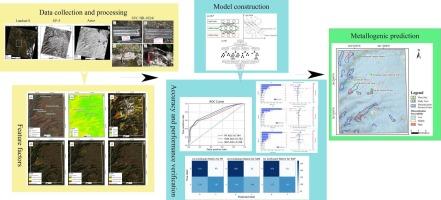基于多源遥感与机器学习的成矿预测——以佳集卡锂矿为例
IF 3.6
2区 地球科学
Q1 GEOLOGY
引用次数: 0
摘要
曾经是亚洲最大锂矿床的嘉吉卡矿,是进一步勘探的目标,以确定该地区的其他矿产资源。在本研究中,我们开发了一个综合的成矿预测框架,该框架将多源遥感数据(包括GF-5、ASTER、Landsat-8和地物光谱数据)与机器学习模型(随机森林(RF)、支持向量机(SVM)和多层感知器(MLP))相结合。主要结果如下:(1)综合3种模型结果,确定了14个有利成矿带,包括3个已知矿位。(2)三种模型中,MLP的性能最高,曲线下面积(Area Under the Curve, AUC)值为0.788,RF的性能最低,为0.742。(3)铁异常、构造密度和电气石蚀变是影响成矿预测的关键因素。其次是与锂辉石矿化、白云母蚀变、硅化、红柱石和绿柱石相关的光谱特征。羟基异常和堇青石蚀变对有利成矿带的识别影响最小。该方法证明了多源遥感数据与机器学习技术相结合在矿产勘查中的有效性,为复杂地质构造地区的成矿预测提供了有价值的见解。本文章由计算机程序翻译,如有差异,请以英文原文为准。

Metallogenic prediction based on multi-source remote sensing and machine learning: A case of lithium ore in Jiajika, China
The Jiajika Mine, once the largest lithium deposit in Asia, is targeted for further exploration to identify additional mineral resources in the region. In this study, we developed a comprehensive metallogenic prediction framework that integrates multi-source remote sensing data—including GF-5, ASTER, Landsat-8, and spectral data of terrestrial objects—with machine learning models: Random Forest (RF), Support Vector Machine (SVM), and Multi-layer Perceptron (MLP). The main results are as follows: (1) By combining the results of all three models, we identified 14 favorable mineralization zones, including three known ore sites. (2) Among the three models, the MLP achieved the highest performance, with an Area Under the Curve (AUC) value of 0.788, while RF had the lowest at 0.742. (3) Iron anomalies, structural density, and tourmaline alteration were key factors influencing metallogenic prediction. These were followed by alteration features related to spodumene mineralization, muscovite alteration, silicification, andalusite and beryl-associated spectral signatures. In contrast, hydroxyl anomalies and cordierite alteration had the least impact on the identification of favorable metallogenic zones. This method demonstrates the effectiveness of integrating the multi-source remote sensing data with machine learning techniques in mineral exploration and provides valuable insights for metallogenic prediction in regions with complex geological structures.
求助全文
通过发布文献求助,成功后即可免费获取论文全文。
去求助
来源期刊

Ore Geology Reviews
地学-地质学
CiteScore
6.50
自引率
27.30%
发文量
546
审稿时长
22.9 weeks
期刊介绍:
Ore Geology Reviews aims to familiarize all earth scientists with recent advances in a number of interconnected disciplines related to the study of, and search for, ore deposits. The reviews range from brief to longer contributions, but the journal preferentially publishes manuscripts that fill the niche between the commonly shorter journal articles and the comprehensive book coverages, and thus has a special appeal to many authors and readers.
 求助内容:
求助内容: 应助结果提醒方式:
应助结果提醒方式:


